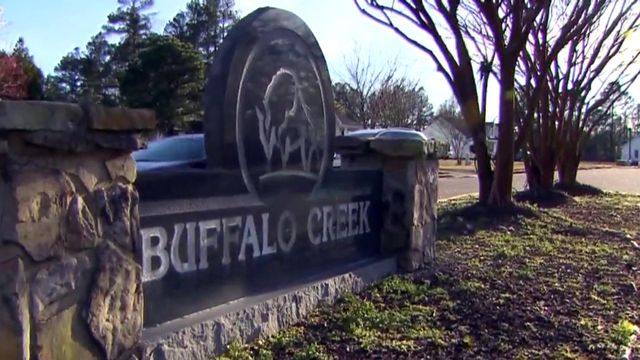Surveyor dropped Duke Energy easement from map before Johnston neighborhood built
Close to 20 homes in a Johnston County neighborhood should never have been built, but a transmission line easement across the properties was left off plat maps before the neighborhood was developed.
Posted — UpdatedHomeowners in the Buffalo Creek subdivision near Zebulon started receiving letters from Duke Energy two years ago informing them their homes, or part of their land, are on property owned by the utility company. Carolina Power & Light, which later merged into Duke, acquired a 180-foot-wide easement in 1987 for future power lines.
Yet, when developer Fred Smith Co. plotted the neighborhood off Thanksgiving Fire Road about a decade later, the planned transmission lines didn't show up in the maps, clearing the way for the homes.
"Something that should have been on the plat didn't get on that plat," said Jim Arges, president of the North Carolina Real Estate Lawyers Association and a former surveyor.
Property records show the same surveyor was involved in both maps: Watkins and Associates recorded the easement for CP&L, and the company, which later became Mauldin Watkins, then recorded the same land without it.
Mauldin Watkins has been named as a defendant in a lawsuit filed by the Buffalo Creek residents. Richard Watkins was listed as registered agent of the original company, but he no longer does surveys and is listed as a real estate agent. He never responded to repeated calls from WRAL Investigates to explain what happened.
Staffers at Mauldin Watkins' Fuquay-Varina office declined to comment.
Arges said he was stunned when he saw the families could lose their homes.
"I immediately recognized that this is a tough situation for everybody," he said.
Neighbors paid for surveys, title searches, real estate agents and attorneys. But their efforts didn't reveal the easement because industry practice relies on the accuracy of a subdivision plat, not older maps.
"Instead of spending a few hundred dollars for a survey and a few hundred dollars for their real estate attorney's fees, you might be talking about thousands of dollars," Arges said of going back decades to check on a property's history.
Aside from some sort of permanent markings for an easement, he said he sees no cost-effective solution to prevent a similar – albeit rare – situation.
Buffalo Creek residents have also named Duke, Smith and others in their lawsuit as they try to salvage their homes or at least a fair settlement. The neighbors allege the utility abandoned the right to the easement after providing electricity for two decades with no mention of the problem.
Duke contends the initial easement was properly recorded and that homeowners' complaints are with the developer and surveyors.
Builder Fred Smith Jr. saying his company acted appropriately and legally when developing Buffalo Creek.
Mauldin Watkins claims in recent court filings that it is protected by a three-year statute of limitations.
"I hope something can be worked out between the power company, the developer, something, because these people come into this thing innocent," Arges said.
Related Topics
• Credits
Copyright 2024 by Capitol Broadcasting Company. All rights reserved. This material may not be published, broadcast, rewritten or redistributed.






